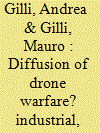|
|
|
Sort Order |
|
|
|
Items / Page
|
|
|
|
|
|
|
| Srl | Item |
| 1 |
ID:
147903


|
|
|
|
|
| Summary/Abstract |
Many scholars and policymakers are concerned that the emergence of drone warfare—a first step toward the robotics age—will promote instability and conflict at the international level. This view depends on the widely shared assumption among International Relations scholars that military hardware spreads easily, especially in the age of globalization and real-time communications. In this article, we question this consensus. Drawing from the literature in management, we advance a new theory of diffusion of military innovations and test its two underlying causal mechanisms. First, we argue that designing, developing, and manufacturing advanced weapon systems require laboratories, and testing and production facilities, as well as know-how and experience that cannot be easily borrowed from other fields. Second, we argue that the adoption of military innovations requires both organizational and infrastructural support. We test our two claims on three types of combat-effective drones: loitering attack munitions (LAMs), intelligence surveillance and reconnaissance drones (ISR), and unmanned combat autonomous vehicles (UCAVs). We find that even wealthy, advanced, and militarily capable countries such as the United States, the United Kingdom, Germany, and France have struggled to produce or adopt such platforms. We conclude that concerns about the diffusion of drone warfare appear significantly exaggerated, as do claims that globalization redistributes military power at the global level. More generally, our analysis sheds light on how the interaction between platform and adoption challenges affects the rate and speed of diffusion of different military innovations.
|
|
|
|
|
|
|
|
|
|
|
|
|
|
|
|
| 2 |
ID:
142309


|
|
|
|
|
| Summary/Abstract |
In May 2015, the Italian Ministry of Defence published its White Paper for International Security and Defence. In this article, Andrea Gilli, Alessandro R Ungaro and Alessandro Marrone examine the important domestic changes outlined in the document, including those made to the policy-making processes and the internal discussion about strategic issues. The document restricts Italy's focus to the Euro-Mediterranean region but sees a more active role for its armed forces - if and when necessary. European co-operation is also prioritised, especially with regards to military technology and procurement. It also puts forward reform of the defence ministry aimed at shaping an integrated approach and promotes further jointness, starting from the strengthening of the Joint Operational Command that will take responsibility for any future military operation.
|
|
|
|
|
|
|
|
|
|
|
|
|
|
|
|
| 3 |
ID:
186098


|
|
|
|
|
| Summary/Abstract |
We test two sets of alternative hypotheses about the demographic composition of the U.S. armed forces. We analyse individual-level data of two national representative samples covering the period 1979–2008. We find that, in contrast to the accepted wisdom, the U.S. military no longer primarily recruits individuals from the most disadvantaged socio-economic backgrounds. Technological, tactical, operational and doctrinal changes have led to a change in the demand for personnel. As a result, on different metrics such as family income and family wealth as well as cognitive abilities, military personnel are on average like the average American citizen or slightly better.
|
|
|
|
|
|
|
|
|
|
|
|
|
|
|
|
| 4 |
ID:
190873


|
|
|
| 5 |
ID:
134006


|
|
|
|
|
| Publication |
2014.
|
| Summary/Abstract |
What explains the adoption of military innovations? In this article, we assess the empirical validity of adoption capacity theory by reconsidering one methodologically important case analyzed by Michael Horowitz: the diffusion of suicide terrorism. We show that, when addressing problems in Horowitz's research design, the case of suicide terrorism fails to support adoption capacity theory. We argue that, in order to account for the diffusion of this innovation, one needs to take into consideration the tactical incentives to overcome technologically superior enemies. The results of our quantitative and qualitative analyses suggest that terrorist groups fighting against very powerful states in terms of conventional capabilities are more likely to employ suicide attacks than those fighting against poorly equipped ones. Our findings are important because they provide systematic evidence in support of Kalyvas and Sànchez-Cuenca's argument that suicide terrorism is driven by tactical considerations and because they provide confidence in the external validity of Berman and Laitin's hardness of targets hypothesis. Our results also question Lyall and Wilson's finding that highly mechanized armies are inherently inadequate to win counterinsurgency operations. The superior conventional capabilities of a counterinsurgency army might in fact make traditional insurgent tactics ineffective and thus give insurgents an incentive to adopt suicide attacks.
|
|
|
|
|
|
|
|
|
|
|
|
|
|
|
|
| 6 |
ID:
163809


|
|
|
|
|
| Summary/Abstract |
Can countries easily imitate the United States' advanced weapon systems and thus erode its military-technological superiority? Scholarship in international relations theory generally assumes that rising states benefit from the “advantage of backwardness.” That is, by free riding on the research and technology of the most advanced countries, less developed states can allegedly close the military-technological gap with their rivals relatively easily and quickly. More recent works maintain that globalization, the emergence of dual-use components, and advances in communications have facilitated this process. This literature is built on shaky theoretical foundations, however, and its claims lack empirical support. In particular, it largely ignores one of the most important changes to have occurred in the realm of weapons development since the second industrial revolution: the exponential increase in the complexity of military technology. This increase in complexity has promoted a change in the system of production that has made the imitation and replication of the performance of state-of-the-art weapon systems harder—so much so as to offset the diffusing effects of globalization and advances in communications. An examination of the British-German naval rivalry (1890–1915) and China's efforts to imitate U.S. stealth fighters supports these findings.
|
|
|
|
|
|
|
|
|
|
|
|
|
|
|
|
|
|
|
|
|